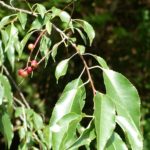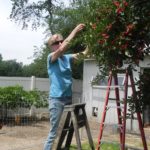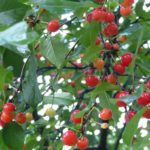Catalog Dreaming
While subzero cold enveloped Winding Pathways we discovered delightful seed and nursery catalogs in our mailbox. Leafing through their photos of rosy ripe tomatoes, peaches, and sweet corn made us dream of warm days as the frigid wind whistled around the house. Catalogs also made us think of our upcoming cherry tree crop.
We love our cherry trees and are happy to have two types growing at Winding Pathways. Most are the wild native Black Cherry, a member of the Rose family and common throughout the Eastern half of the United States.

Black cherry juice was mixed with brandy or rum to make “Cherry Bounce.”
Early pioneers sometimes called this tree the Cherry Bear because bruins would walk for miles to feast on its juicy fruit. Bear cubs learned how to climb trees by following their mother up the trunk to reach ripe fruit.
Birds love wild cherries. They’ve helped spread this tree far and wide by feasting on a cherry dinner here and then flying there to poop out the seeds. In many areas, the American Black cherry is almost an invasive species, but one with many attributes.
Thomas Jefferson’s Cherry Tree Wood
People today rarely bother eating the bitter small fruits, but pioneers made Cherry Bounce by mixing the juice with brandy or rum to make a bitter, but flavorful, cordial. Most people today enjoy this tree for its beautiful cabinet wood. When newly cut it is goldish in color, often with an intricate grain pattern. The wood darkens with age. Visitors to Thomas Jefferson’s home, Monticello, Charlottesville, Virginia, often wonder why our third president loved such dark paneling. They don’t realize that when he lived there the newly installed wood glowed with cherry’s warm texture. Two centuries of aging have darkened it.
In our mail recently came the newsletter of the National Arbor Day Foundation with an amazing story about today’s popular Bing Cherry. That’s the delicious fruit often sold in grocery stores to be eaten fresh. In 1847 Henderson Lewelling, of Salem, Iowa, loaded his eight children, pregnant wife, and 700 of his prized cherry tree shoots packed in dirt-filled boxes, into wagons for the long trek to Oregon. They endured freezing temperatures, scurvy, and dysentery but made it and established the Pacific Northwest’s cherry industry.
Two Types
Today, two types of domestic cherry are readily eaten by people. They are distinct from the American Black Cherry and are native to Europe and Asia. One type is called Sweet Cherries with the Bing variety best known. They are delicious when eaten fresh. Sweet cherries thrive in California, Oregon, Washington, Idaho and Montana but don’t like the upper Midwest’s harsh winters. Ironically, Bing cherries got their start in Iowa but don’t grow well in the state today. We don’t have any at Winding Pathways.

Tart cherries make great pies.
We love our sour cherries. They thrive here despite winter’s cold and summer’s inferno, yielding an abundant crop in June. Most commercial sour cherries are grown in Michigan, but they love Iowa. Our favorite variety is the Dwarf North Star. It resists bugs and diseases, and even the deer leave it alone. In some years our cherry crop is almost sweet enough to eat fresh. We love them best blended with mulberries in a pie or mixed into oatmeal. A handy cherry pitter removes some of the tedium of evicting the big seed from each fruit.

Tart cherries come ripe in June.
Planting a sour cherry in the yard yields delicious fruit for a family to enjoy. Dwarf varieties can be bought from many nurseries. They like full sun and don’t take much space. In contrast, plant an American Black Cherry and eventually, it will produce fruit savored by birds. The tree needs plenty of space. It can grow to 100 feet tall and likes full sun.
Two Great Sources to Learn About Trees

Elegant lodging awaits at the Lied Lodge.
The Arbor Day Foundation, arborday.org has a wealth of information about trees and sells dozens of species at low cost. A few years ago, we enjoyed a delightful visit to Arbor Day Farm in Nebraska City, Nebraska. We overnighted in the Lied Lodge on the property and wandered trails while enjoying tree lure. Adjacent is the home of J. Sterling Morton, Arbor Days founder.
A wonderful old book on tree natural history is a two-volume series called A NATURAL HISTORY OF TREES OF (Eastern or Western) NORTH AMERICA. If you find one at a used book store…….buy it!
ARBOR DAY
Most northern states honor Arbor Day on the Fourth Friday of April each year, but many southern states celebrate it at seasons more appropriate for planting in their climate. Arbor Day dates for all states are listed on this link.

